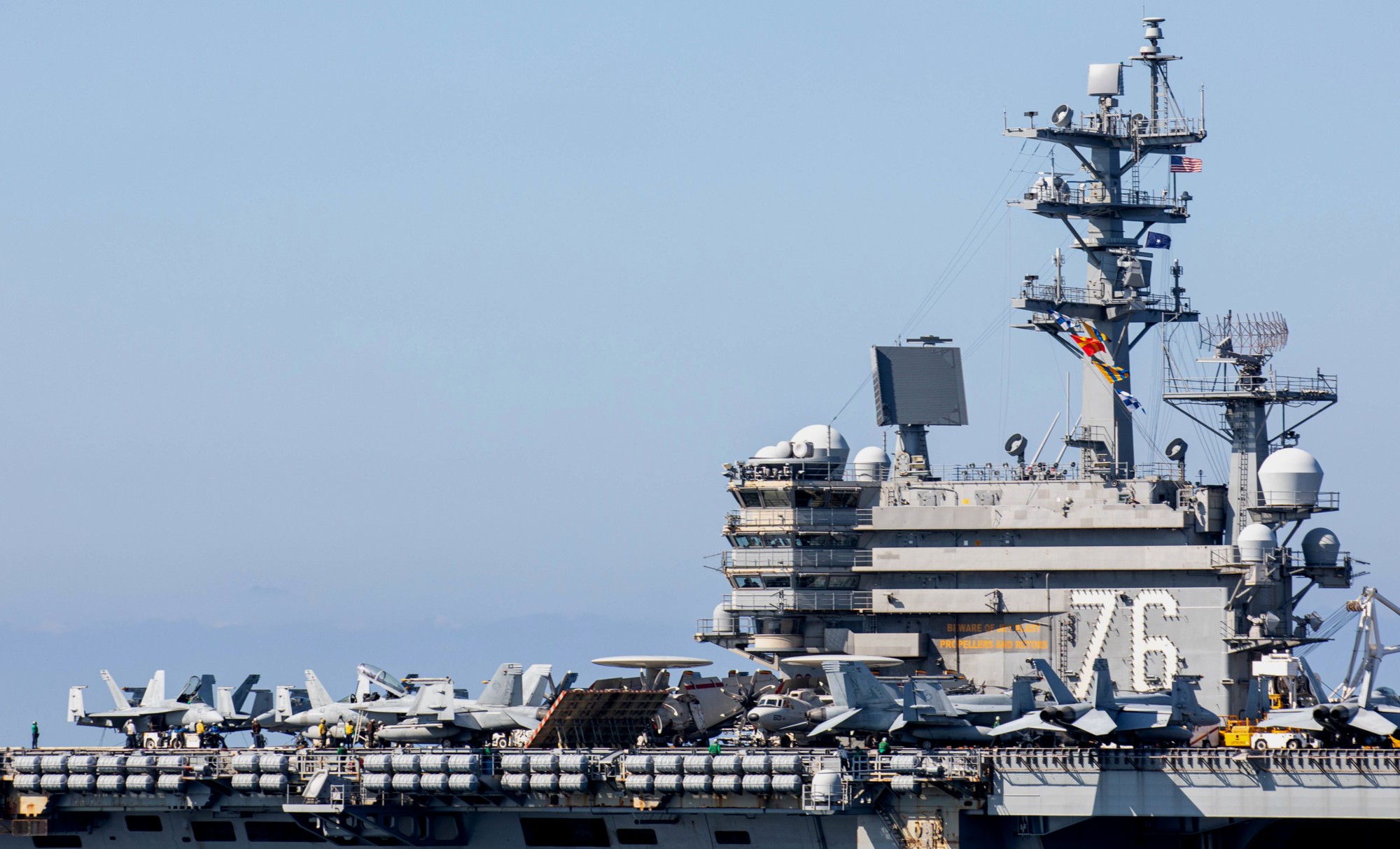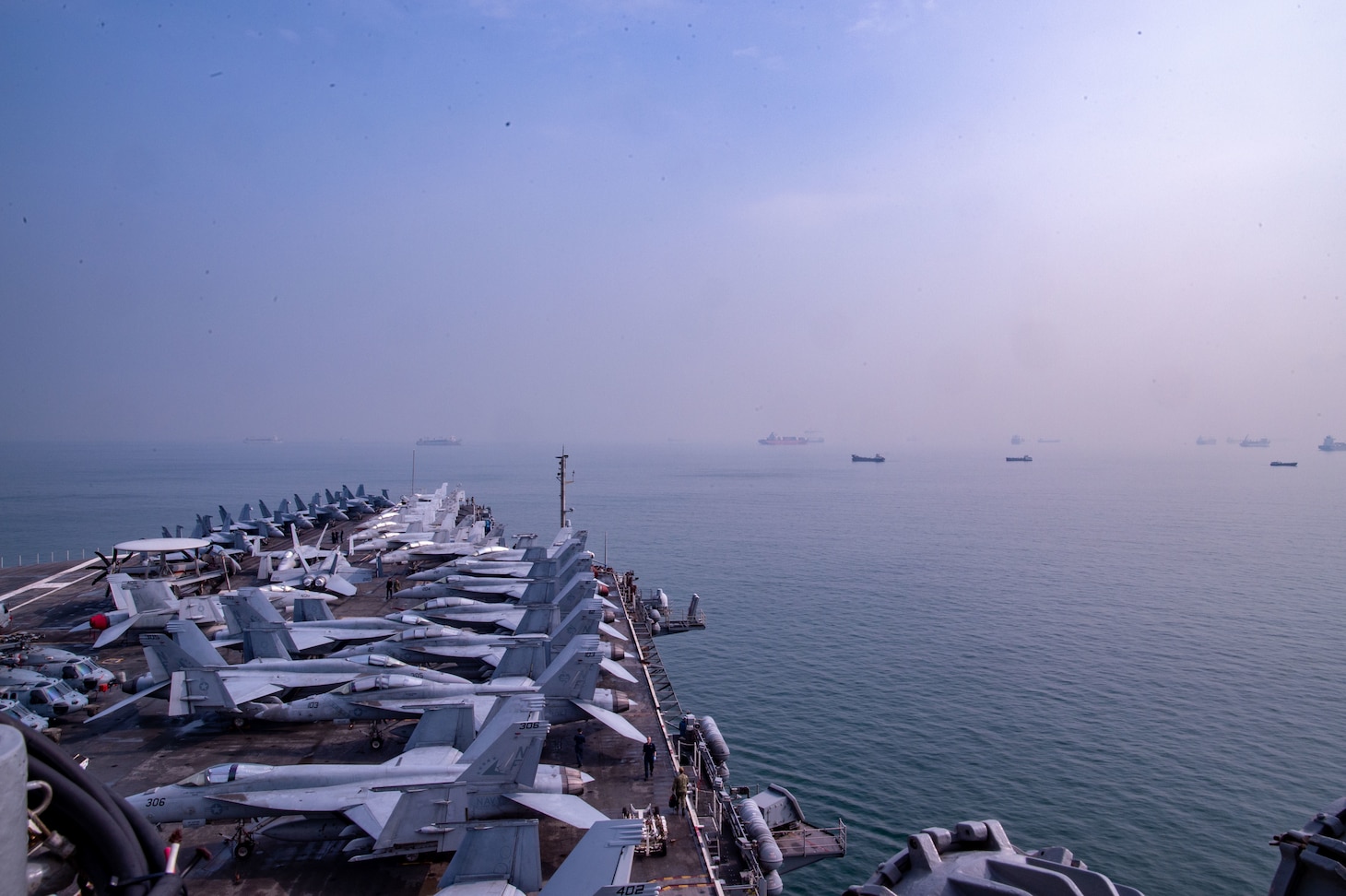Reagan Aircraft Carrier - USS Ronald Reagan (CVN-76) is a Nimitz-class, nuclear-powered submarine in service with the United States Navy. A ship of the ninth class,
She was named in honor of Ronald W. Reagan, President of the United States from 1981 to 1989. She was built at the Newport News Shipbuilding in Newport News, Virginia and launched on 12 July 2003.
Reagan Aircraft Carrier

Ronald Reagan flew five missions to the Pacific and Middle East between 2006 and 2011 while stationed at North Island Naval Station. In October 2015, Ronald Reagan designated USS George Washington as the flagship of Carrier Strike Group 5, the only conventional strike group homeported in Yokosuka, Japan as part of the US Seventh Fleet.
Uss Ronald Reagan Departs Yokosuka To Resume Patrol > U.s. Strategic Command > News Article View
Beginning in 2016, Ronald Reagan began annual summer patrols of the western Pacific in the US Seventh Fleet area.
Former President Ronald Reagan and First Lady Nancy Reagan, and Newport News Shipbuilding Company President William Fricks stand behind a model of the aircraft carrier USS Ronald Reagan (CVN-76). This model was presented to President Ronald Reagan in May 1996.
The contract to build Ronald Reagan was awarded to Northrop Grumman Newport News Shipbuilding and Dry Dock Company in Newport News, Virginia on December 8, 1994 and her keel was laid on February 12, 1998. Many ships. times, and eventually 4.5 billion dollars were spent on its construction.
Ronald Reagan was baptized by Reagan's wife, Nancy, on March 4, 2001, at the Newport News Ship Building.
Ronald Reagan Carrier Strike Group Provides High End Support In South China Sea > U.s. Indo Pacific Command > 2015
And the ship was launched on 12 July 2003 in Norfolk harbor with Captain J. W. Goodwin in command.
Vice Presidents Dick Chey and Lynne Chey both remained silent during the ceremony, as did Nancy Reagan, who gave the crew their first traditional order as a naval unit: "Take control of the ship and bring her in alive." Ronald Reagan made his maiden voyage on July 21, 2003. President Reagan, who missed both inaugurations due to Alzheimer's disease, died 11 months later. During the graveside service, the ship's commanding officer at the time, Captain James Symonds, raised a flag depicting the former president's casket at Mrs. Reagan's request. This is also the flag flown on Capitol Hill that was inaugurated by the President on January 20, 1981. Recently, Captain Symonds also presented Mrs. Reagan with a flag raised by the late Ronald Reagan.
Ronald Reagan was the first aircraft carrier and the first nuclear-powered fighter jet of any kind to be named in honor of a former living president.

Unlike other politicians honored by inclusion in this category, Reagan had no connection to the US Navy except for his tenure as commander in chief, although one of his most important tasks in office was planning. 600 ships.
U.s. Aircraft Carrier In South Korea For Joint Drills To Deter North Korea
The design of the Ronald Reagan seal was painstakingly created by her staff with historic contributions from staff at the Ronald Reagan Presidential Library Foundation. The red border emblazoning the ship's seal is similar to the red border defining the White House china designed for the Reagans during their White House years. The four gold stars represent Reagan's 40th presidency and the four pillars of freedom: freedom, economic opportunity, international democracy, and national pride. "Peace through strength" was a recurring theme of Reagan's life in public service. The ship was based on the West Coast, responding to Reagan's two terms as governor of California and as a port of call on the Pacific Ocean. The three patriotic flights represent three major military operations under Reagan's presidency: Operation Urgent Fury (Grada/1983), Operation El Dorado Canyon (Libya/1986), and Operation Praying Mantis (Iran/1988). The worldview reflects Reagan's view of global democracy and the United States as a deterrent to the nation's national pride. Red, white and blue colors dominate the seal, representing the American flag.
On May 8, 2004, five months after the earthquake, Ronald Reagan received its second flight certificate, which covers all operations of the aircraft, including launch and recovery, emergency and rescue, and fuel certificates, fuel, training.
Ronald Reagan was the first transport from the port of Norfolk, Virginia, through the Straits of Magellan to the new port at Naval Air Station North Island, San Diego, with Captain James A. Symonds.
The carrier air wing Elev, normally assigned to the USS Nimitz, accounts for about 25 percent of its total transport capacity. Squadrons flying the aircraft are VFA-14 and VFA-41 flying the F/A-18E/F Super Hornet, VAW-117 flying the E-2C Hawkeye 2000, HS-6 flying the SH-60F Seahawk, and VRC-30. C-2A Greyhound. The plane visited Rio de Janeiro, Brazil on June 5, 2004, and Reagan died on the first night of the plane's arrival. A ceremony was held in his honor on board later that evening, shortly after the public playing of the US national anthem. After leaving Rio, Ronald Reagan transited through the Straits of Magellan on 20–21 June and then visited the ports of Valparaiso, Chile and Callao, Peru before arriving in San Diego on 23 July 2004. From 1 October 2004 he was designated as Ronald. Reagan. to Carrier Strike Group Fifteen.
Sole U.s. Aircraft Carrier In Asia Pacific To Help With Afghanistan Troop Withdrawal
Ronald Reagan (front) with Kitty Hawk (cter) and Abraham Lincoln (back) on the first cruise in June 2006
Ronald Reagan, now with Terry B. Craft in command, departed San Diego on January 4, 2006, on her maiden deployment to conduct naval operations in support of Operation Freedom and Operation Iraqi Freedom and conduct maritime security operations in Persia. Gulf On January 28, 2006, an F/A-18 Hornet attempting to land at Ronald Reagan crashed into a dock 200 kilometers (120 mi) southeast of Brisbane, Quesland. The plane hit the third missing cable and went through it. The pilot escaped safely, but the plane was lost.
While in Brisbane Harbour, the bulk carriers became clogged with 1,900 pounds (860 kg) of jellyfish, causing problems for the larger MMRs and preventing cooling for the main engines.
The aircraft crossed the Gulf on 22 February 2006 and returned from service on 6 July 2006.
Supercarrier: Uss Ronald Reagan (tv Movie 2007)
Ronald Reagan and her Carrier Strike Group (CSG) departed Coronado, North Island, San Diego on January 27, 2007 on an unscheduled mission.
To the Western Pacific, she filled the role of forward carrier Kitty Hawk while continuing her mission in Japan. On April 20, 2007, Ronald Reagan and she returned to CSG Coronado. "Surge Deploy" is part of the Naval Response Plan, which gives the United States the ability to respond to any global engagement with a flexible and sustained force and the ability to respond quickly to multiple situations at short notice.
In January 2007, it was announced that Ronald Reagan had received the 2006 Commander's Medal, the Air Forces Pacific Carrier Battle Efficiency "E" Medal for the West Coast, the first battle of the "E" for the carrier.
Ronald Reagan returned to North Island Naval Base on 20 April 2007 after spending three months supporting operations in the Western Pacific.
U.s. Aircraft Carrier To Visit South Korea For First Time Since 2018
On December 15, 2007, the carrier responded to a distress call from a vessel off the coast of Baja California. An SH-60 helicopter flew the Illinois Tiger, Ronald Reagan's appendix burst while on a Mexican cruise, in which a flight pathologist performed an emergency.
On September 25, 2008, Ronald Reagan hosted a Grammy Award-winning rock band while on tour in the Gulf of Oman. Over 1500 personnel thronged to witness the team's performance.
Ronald Reagan, including CVW-14, departed San Diego on 19 May 2008 to transport 7th Fleet and 5th Fleet.
The Ronald Reagan CSG conducted humanitarian and relief operations in the Philippines on June 24, 2008 after Typhoon Fgsh devastated the Philippines, killing hundreds of people from island regions and the main island of Luzon. The storm also capsized the passenger ship MV Princess of the Stars.
Nimitz Class Aircraft Carrier
Escorts of Ronald Reagan and CSG 7, operating in support of the Philippine Army, concentrated their efforts on Panay Island in Ctral Visayas. Over the course of eight days, SH-60 Seahawk helicopters and C-2A Greyhound aircraft from the Ronald Reagan CSG helped deliver more than 519,000 lb (235,000 kg) of rice, drinking water, and other supplies to areas of Panay. Unable to reach by truck due to floods. The operation in Panay earned him the Navy Commendation Medal.
The CSG arrived in the US fleet area on August 28, 2008, and has launched more than 1,150 sorties to Afghanistan in support of Operation Enduring Freedom. Ronald Reagan returned to San Diego on November 25, 2008.
On 28 May 2009, Ronald Reagan deployed to the 7th and 5th Fleet areas of responsibility with Carrier Air Wing 14.
Ronald Reagan unloaded the Dwight D. Eshower CSG and launched its first sortie in support of OEF on 6 July. Ronald
Us Aircraft Carrier Ronald Reagan Returns To Manila After 3 Years
Reagan class aircraft carrier, ss ronald reagan aircraft carrier, how long is the ronald reagan aircraft carrier, us aircraft carrier ronald reagan, aircraft carrier uss ronald reagan, ronald reagan aircraft carrier pictures, aircraft carrier reagan, the ronald reagan aircraft carrier, uss reagan aircraft carrier, aircraft carrier museum ships, reagan carrier, ronald reagan aircraft carrier

0 Comments